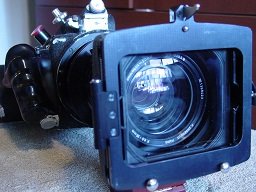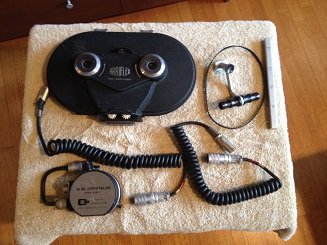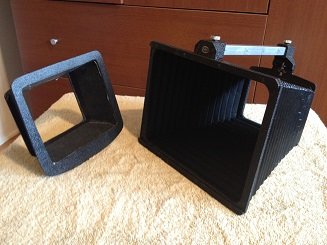Search the Community
Showing results for tags 'FILM'.
-
I have a cousin who's currently working to produce a programme (pitch an idea for them), that would be play on tv. but they (tv station) wanted to discuss the salary when he comes up with an idea they want to make. basically they want to collaborate with him. so his question is: 1) How much should he get paid if he works as a (writer/director/cinematographer), as the tv station want to discuss that with him. how much is the usual pay for ppl in that position? btw, he has graduated from university (he's experienced in making film etc, few of his films had gotten into festivals as well) 2) Do he need to sign a contract with the station for his idea? (e.g. if he wants to also put the show on his youtube account to help show his works) 3) and how to protect his idea so the tv station won't steal it from him, as he seems worried about that.
-
Hello fellow cinematographers and film makers! If I could borrow 3,750 frames at 24fps of your time to review my new reel on my website listed below. It would mean a great deal to me if you could offer some critique afterward. I'm in the middle of a huge push to take my work and career to greater quality and new opportunities. I would be happy to return the favor. Thank you and happy shooting! Alex www.alexfuerst.com
- 2 replies
-
- reel
- cinematography
-
(and 7 more)
Tagged with:
-
WANTED: ARRI Super 35 Ground Glass & Arriglow Mask
Jesse Kreitzer posted a topic in Cine Marketplace
Greetings, I'm looking to purchase ground glass and matching glow mask for an ARRI 535B. 1.85 glass preferable, but 1.78 and 4.20 are also welcome. Thank you for your help. -
BURBANK, CA - FotoKem recently completed the digital intermediate and post production services for the indie film Palo Alto. Working with director/screenwriter Gia Coppola and cinematographer Autumn Durald, FotoKem colorist Alastor Arnold fine-tuned the natural look created in camera to ensure the filmmakers' vision for this teen tale is reflected on the big screen. Based on James Franco's short story collection about rebellious high school kids in suburban California, Palo Alto has been praised for Coppola's coming-of-age storytelling and for Durald's evocative photography. The film, which marks Coppola's feature debut, garnered raves at the Tribeca, Telluride, Toronto and Venice film festivals before its recent release. "Gia and I had worked together on five projects prior to this feature, so we have a similar visual language, taste and sensibilities," says Durald. "Gia is from a photography background, and we pulled a lot of photographic references for the tone and mood we wanted - photos by Stephen Shore and William Eggleston. It was important to have a more filmic, softer texture to the image that harkened back to movies like The Outsiders and Dazed and Confused - something that looked more aged with softer tones in the blacks as well. And nothing overly saturated and contrasty." Durald shot the feature with a Panavised RED Epic camera, mounted with Panavision Super Speed lenses and vintage 1970s glass to give a softer feel to the image. The on-set DIT handled basic data management and adjusted stills in REDCINE-X, but no LUTs were applied. Durald's RED raw R3D files were transcoded for final color using REDlogFilm for flexibility with various film/lab emulations. When Coppola and Durald met with Arnold, they brought their look-book of still photography and suggested some films for him to watch, including The Last Picture Show, American Graffiti and The Virgin Suicides. They also experimented with different combinations of film emulation LUTs and grain treatments on various scenes from the feature. "First and foremost, they wanted a very filmic approach to keeping the image natural, smooth, and most importantly beautiful," recalls Arnold. "We weren't pushing in a hyper digital direction. Autumn's photography was awesome, a unique look with a consistency of tonality - it was in a very warm place with naturalistic skin tones." Arnold demonstrated Fuji and Kodak film emulation LUTs along with variants involving slightly different color spaces and lab processes. "We were really happy with the Kodak LUT as the base, and then we added grain over that as well," says Durald. Using the Quantel Pablo for grading, Arnold suggested using its noise treatment feature in different blending modes and intensities to give a grain pass to the entire film. "It all ran in real time, so it was really interactive and fast to adjust noise to emulate different exposures," he reports. He gave particular attention to sodium vapor night exterior shots, tilting toward warm ambers instead of greens and making sure that black levels "felt appropriate for night but didn't bury anything - you always felt you could get into them." Arnold credits Durald's talents as a DP with making the DI process more about collaboration and experimentation than fixing things. "We never struggled to match a key to another key or to even things out," Arnold notes. "It was all about finding the right feel, tonalities, densities and grain. It was great to have the filmmakers walk in with a concise understanding of where they wanted to go stylistically with the finish." Durald concludes, "Alastor has a really great eye - he understood what we were going for from the outset. It's really important to find people with the same taste and sensibilities you have who can translate your visual language emotionally and technically."
-
- post production
- digital
-
(and 4 more)
Tagged with:
-
HOLLYWOOD - Six of the industry's leading brands - Anton/Bauer, Bexel, Litepanels, OConnor, Sachtler and Teradek, all part of the Vitec Group - will be demonstrating a range of their latest, innovative products at the upcoming Cine Gear Expo on June 6-7 in Los Angeles, at booths #64-66. Cine Gear Expo offers film, video and broadcast media makers an opportunity to discover the latest technology and techniques, get hands-on training, gain knowledge and skills from industry leaders, obtain the newest equipment, hear breaking industry news, and network with peers and industry leaders. In addition to a prize drawing for a new Litepanels product, highlights of the advanced portfolios being shown by these brands include: Anton/Bauer® will officially release its V-Mount Digital Battery™ Series. The company's revolutionary Digital Battery Series is the first battery line designed specifically to power digital production for the cinema and pro-video sectors. The new battery series, also available with Gold Mount® connectors, meets the unique needs of 4K camera set-ups and other digital cameras in use today, while providing top-tier levels of safety, performance and reliability. With the introduction of a V-Mount option to the Digital Battery Series, Anton/Bauer's best of breed batteries will now be available for use with any camera and any accessory, and includes three battery sizes (90 Wh, 150 Wh, and 190 Wh). Litepanels will officially launch its much anticipated next generation LED panel series, in addition to showcasing the recently released Sola 9 (daylight balanced) and Inca 9 (tungsten balanced) LED Fresnels. The new 9-inch fixtures fill a market demand for medium-sized LED Fresnels. Litepanels' industry-leading collection of LED Fresnels now covers the complete range needed to deliver a full LED solution for broadcast studios, episodic television, and feature film production. Also making its Cine Gear premiere is the new Hilio D12 (daylight balanced) and Hilio T12 (tungsten balanced) high light output panels. The innovative panels provide the light quality, versatility and intensity of an open source fixture, while offering all of the benefits of Litepanels' proprietary LED fixture design. OConnor will present a growing line of camera and lens accessories. Engineered to address the needs of today's fast-paced production environments, the line includes the CFF-1 and O-Focus Dual Mini follow focus systems relaunched in Photo and Cine Kits, the award-winning O-Box WM mattebox, innovative O-Grip Handgrip System and the Universal Baseplate. Sachtler will display the Ace Accessories, a new range of premium camera support gear, which includes the Ace Base Plate, Ace Follow Focus and Ace Matte Box. The accessories can be bought individually or as a package. Sachtler also will showcase its redeveloped Ace L fluid head, now compatible with all types of sliders. The Ace L 75mm tripod head can conveniently be converted to a flat base, through the removal of a bottom screw, and mounted on a range of sliders. The Ace L is extremely versatile with a payload range of up to 6 kilograms and can be used with three different carbon fibre tripods - the floor spreader, mid-level spreader or telescopic tripod system. The product also features the seven-step counter balance, patented SAdrag™ and illuminated level indicator to ensure precise and smooth camera operation. artemis, the camera stabilizer system by Sachtler, will also be on display. Whether it's a film, worldwide live-broadcast of a sporting event, or a TV show, artemis camera stabilizer systems are always used when perfectly balanced pictures of moving subjects are required. Bexel and Teradek, also Vitec Group companies, will be exhibiting at Cine Gear Expo. Bexel (booth #98c) provides brilliantly designed and flawlessly executed systems and solutions to producers of some of the biggest and most important televised events in the world. Experts from Bexel will be on hand to discuss their end-to-end solutions, including systems integration, fiber and infrastructure support. Bexel representatives can discuss new and used professional audio, video and fiber equipment solutions, as well as elaborate on their comprehensive broadcast rental equipment and technical services for television productions. Teradek (booth #119) will showcase their brand new Bolt Pro series of zero-delay wireless video products, along with their Serv and Cube Pro encoders, which offer users real-time HD monitoring on iOS and Android smartphones and tablets. The Vitec Group brands are technology leaders in the broadcasting, pro video and cinematography marketplace. They are characterized by innovation, reliability and long-term cost savings, with the highest levels of customer support. For further information visit their booths at Cine Gear Expo.
-
- LED lights
- accessories
-
(and 4 more)
Tagged with:
-
Hello everyone! My name is Grant. I'm a cameraman/editor from Russia. I'm 21, and I spent 5 years on learning and practicing in video industry. My dream is to shoot beautiful and interesting adverts/films with people who love it too. Unfortunately I live in Russia, in city where only weddings are popular, and no one need true quality. Of course, I participate in some "Big Moscow projects" but I understood, that the capital is not for me (non professional reasons). And now I decided to find a studio or comp., to work with outside Russia. And it is even doesn't matter where - Europe or USA/Canada. But move to another country without any contacts might be risky I want to ask you about any ways to implement my dream. Thank you for any advice. And have a nice day.
-
- Employment
- studios
-
(and 5 more)
Tagged with:
-
Hi everyone, we wanted to write in and say thanks. We're so grateful for your feedback and support on this project. First phase of the 3-axis time-lapse moco rigs now in production. Phase 1 shipping is schedule for this month. Video overview here: https://vimeo.com/93078265 Lightweight at 3 pounds per unit with motor or 7 pounds for pan/tilt configuration. Super strong handling up-to 20 pound payloads. Highly configurable with 100s of possible combinations and last but not least affordable at $350 per axis. Please keep the ideas coming as we work towards final design. Phase 2 ships towards the end of summer. Can't thank you enough for your support.
-
Hello all, This is my first post. I am a photojournalist by trade, but I recently picked up a Revere Model 99 Standard 8mm Ciné Camera for a good price at a Flea Market. I was wondering a few things. What are some good sources for Standard 8mm film? Also, it came with two telephoto lenses... both had focuse rings that seem stuck. Is this a matter of dissasembly, or am I missing a trick to get them moving? The aperture rings work great... Thanks for any advice or information. I'm not sure if there's a digitized users guide, but it would be most helpful in learning its operation. If I can get it running, I'd like to take it along on an assignment to India this summer... when I have some down time, a film about the Nihang Sikh warriors would be fun to shoot in this old format. :) Thanks again everyone! www.brundinphotography.com
-
I currently don't have much knowledge at all regarding video, but am looking to get in to it. I have a very limited budget but will be going to Thailand at the end of the month and hope to get some footage. I know someone selling a Leica V Lux 1 for cheap, it seems to be a good choice. A sample of the type of footage I hope to achieve is linked here: I realize that this is made on film and to achieve that myself will require lots of editing work. I just wanted some opinions on how viable this is with the Leica V Lux, or any other entry level camera. If it isn't, I'm fine to hear it, I just am having trouble finding information. Any advice is much appreciated.
- 2 replies
-
- leicavlux1
- film
-
(and 2 more)
Tagged with:
-
Hi, Does anyone know of the cheapest place to buy Double 8MM film in the UK? I've looked around various places but it's all in the £25+ for 25ft of Black and White. I've noticed on B&H in the states it's cheap as hell, and would work out at about £7 in UK pounds. Why is it so expensive over here? Am I missing something? Thanks, Andrew.
-
Hey everyone, I'm looking into the whole shooting on 35 mm 2 perf thing right now for my first "professional" short movie, and what scared me mostly about 35 mm was not being able to really see what's being shot other than on a shitty quality video tap or assist, but I read here the other day someone talking about using an HD monitor and feed it the composite signal from the camera and having a much better quality, is this really possible? I read otherwise about the HD IVS by Arri but it seems ridiculously pricey, otherwise, it seems like the Penelope has actually a pretty decent, much better video feed, what do you guys think? Love this forum by the way, so many resources !
- 42 replies
-
I am looking for a cinematographer. I am filming a pilot episode for my short drama next week Monday and Tuesday in Watford (UK) and next week Friday in Middlesex Hendon (UK). Then the following week beginning the 21st we plan on filming episode 2. We have a few independent production companies interested in this drama. Would you be available? Do you have your own equipment? For more information email me at jevan_buckley@hotmail.co.uk Thank you Jevan
- 2 replies
-
- cinematographer
- student
- (and 7 more)
-
Hey friends, I have been working on this film for the last year, shooting all in 4K (Via Red Epic or time lapses from a Canon MKIII processed into 4k standard 3840x2160) Please take a look and let me know what you think: Watch in 4K Would love to hear your feedback. If you dig this project help us finish it by sharing this link: https://www.kickstarter.com/projects/1503578410/secrets-of-the-west-a-4k-adventure Thanks all!! -James
-
I'm having trouble understanding the difference between Filmic pro and Artemis viewfinder. I know that they are perfect apps for filmmaking on the iphone but don't know how to use. Plus I want my film look to be baroque and colorfully artistic looking that giallo can accomplish. I'm into the Italian cinema because of their lack of perfection of cinema. I just want to know which is the best app for the iphone 4s can make a perfect giallo, and baroque look on film?
-
Excellent Condition. Please contact Rebecca 206.251.9526 ARRI Follow-Focus (see pages 39-41) ARRI FF3 2-SPEED FOLLOW FOCUS FOR 19MM RODS ARRI, RED, PANAVISION 1 - ARRI FF3 Follow Focus 1 - ARRI FF3 Right Focus Knob 1 - ARRI FF3 Right Focus Knob Extension 1 - ARRI FF3 Prime Lens Gear 1 - ARRI FF3 Zoom Lens Gear 2 - ARRI FF3 Marking Disks 2-speed follow focus for video and film cameras. 2-Speed Follow Focus Follow Focus For Video And Film Cameras Efficient Snap-On Mounting Flexible Mounting Options: • Snaps Onto Lightweight Rods • Snap-On Adapter For 19mm Rods • Compatible With FF-4 Accessories
-
Selling my used LOMO Anamorphic zoom 35OPF18-1A 20-120mm with anamorphic adapter (back) which makes it a 40-240mm T3.4 anamorphic monster. Its one of the last Lomo Zooms and higly regarded as one of the best. It can match the Lomo roundfronts primes.. Used but glass is clean and zoom and focus is smooth. Will be shipped in wooden box. Its still in original OCT-19 mount but can be made into PL or use an adapter RED, Micro 4/3, Sony and others are available.. I can send pic´s if interested. My price 2000 euros Located in Sweden read more about it here http://www.cinematography.com/index.php?showtopic=36871
- 2 replies
-
- lomo
- anamorphic
-
(and 3 more)
Tagged with:
-
In the 86-year history of the Academy Awards®, no best picture winner has ever been made without motion picture film technology - a streak that continued with 12 Years a Slave winning the 2014 Oscar®. In addition to best picture, films originating on Kodak also won Oscars® in best foreign language film (The Great Beauty) as well as best actress (Cate Blanchett for Blue Jasmine), best supporting actress (Lupita Nyong'o for 12 Years A Slave), and adapted screenplay (12 Years a Slave). Every Academy Award®-winning actress and supporting actress has had her winning performance captured on film. Earlier in the weekend, Film Independent's Spirit Awards were dominated by 12 Years a Slave which took home awards for best feature, cinematography, directing, screenplay, and supporting actress. In the history of the Independent Spirit Awards, every best picture winner has originated on film. Other films on Kodak that received Spirit Awards were Fruitvale Station (Best First Feature), Blue Jasmine (Best Actress) and Mud (Robert Altman Award). "We're honored so many exceptional filmmakers selected KODAK Film to tell their award-winning stories," notes Andrew Evenski, president and general manager of Kodak's Entertainment and Commercial Films Group. "Filmmakers choose celluloid for the rich detail and bold colors which help convey emotions and visual nuances that resonate with audiences. We're proud of our long history with the motion picture industry - a relationship we look forward to continuing." Kodak's Entertainment Imaging Division is the world-class leader in providing film, digital and hybrid motion imaging products, services, and technology for the professional motion picture and exhibition industries. For more information, visit www.kodak.com/go/motion. Follow Kodak on Facebook (www.facebook.com/KodakMotionPictureFilm), Twitter (@Kodak_ShootFilm) and YouTube (www.youtube.com/KodakShootFilm).
-
- 1
-

-
- Film
- Academy Awards
-
(and 3 more)
Tagged with:
-
Hey guys, I'm looking for a bit of advice, stock-wise. We're shooting the first ten minutes of our feature film this month and unfortunately my DP is as unfamiliar with film as I am. For outdoor scenes, I'm looking into the KODAK Vision 3 250D. One shot in particular, we transition from the roof of our building to the inside of our apartment. I dug up an article on Fuji's old 250. The tester claimed it would work very well under such a transition. I'm assuming that Kodak can achieve the same result? http://www.fujifilm.com/products/motion_picture/lineup/eterna_vivid250d/demo/ what would you recommend, lighting-wise, once we hit the interior. In the same one-shot, we travel quite aways around the apartment. Sometimes, windows are plentiful, sometimes not so much. for everything else, I thought we could use kodak 500t. but I don't know how that would match up either. does anyone know if I'm looking in the right places? if not, can you point me in the right direction. (i also considered throwing an 85 on something like a 200t to achieve the same effect, but I'm new at this, and I don't really know what I'm talking about) thank you for your help, for more information on our movie check us out at po.st/sowhat
-
My name is Jamila J. Brown and I'm a screenwriter looking for a cinematographer to bring my short film to life. The film is called "Gofish" and it's about an intercultural friendship between a black and Jewish girl take place in Crown heights, Brooklyn shortly after the riot of 1991. If you're interested in being apart of this project please email me your resume and short clip(if you have) of your work at jamilajjb@gmail.com
-
Hi! Met Film School in London has got these two weekend-courses that I would love to recommend (filmmaking). The school is located ten minutes walking distance from the station: Ealing Broadway. The famous studio "Ealing studios" is right next to the school. Maybe you can meet up with Daniel Radcliffe after school? Never done anything with filmmaking before? Then you should apply for the course: DSLR for professional filmmaking. It is a weekend course that is designed for those with a working understanding of the principals of cinematography or stills photography that want to apply this knowledge specifically to shooting with digital SLR cameras. You will learn how to get the best from a DSLR camera and how to make use of a selection of accessories specifically designed for video shootings on stills cameras. Through a range of creative exercises you will discover the pros and cons of working with these systems and how to avoid some of the most common pitfalls. Done some filmmaking before? Do you want something more advanced? You should apply for our course: Advanced DSLR for professional filmmaking. This course is designed for students who have previously completed the DSLR for professional filmmaking course, or those with an extensive DSLR and/or cinematography background. This programme covers areas from focus and operating, to sound sync and postproduction workflows. The aim of this programme is to provide you with the fundamental knowledge to shoot and finish DSLR video footage to its highest standard. Apply now on their website: http://www.metfilmschool.co.uk/
-
Hi all, I've recently finished shooting a music video on 4-perf 35mm, 5219. I'm about to send the film off for processing/transfer and I'm sort of stuck as to whether I should get an HD telecine or a 2k scan. The price difference given the amount of film I'm working with is not that large of a concern. My lab of choice (the wonderful Video and Film Solutions in Maryland) uses a Spirit for both. Now obviously, as it's a music video, it'll only ever be viewed on computer screens, so I'm sure the difference won't be too drastic between the two, but there are still some factors to consider. First off, a solid amount of the video is shot in a city (Richmond, VA) at night, with only available light, meaning I was basically consistently rating the film at around 2000 ASA, sometimes higher. So grain will definitely be an issue, and on top of that, I plan on pushing a few of the rolls 1 stop. From my previous experience with 2k scans, it seems as if the higher resolution relative to HD makes grain seem even more apparent in scans than it does in telecine, so would the combination of the thin negative, the push, and the 2k scan make the grain way too intense? I understand that "way too intense" is a vague quantifier, so I guess to put it a bit better, would I be better off in terms of keeping the grain at a manageable level (given the negative that I'll be working with) with an HD telecine or a 2k scan? And I guess in a more general sense, what would be the advantages (or disadvantages) of going with 2k in this situation? Also, this may be a stupid question, but just to clarify my understanding, it's definitely possible to maintain the 1:33 aspect ratio with an HD telecine, right? Any time I've previously had HD telecine of 35mm it's been automatically cropped by the lab to conform to a 1920x1080 frame. But theoretically wouldn't it be possible to maintain the full 4-perf frame with no cropping if I specifically instructed the lab and just have bars on the left and right of the frame? The film was framed for and always intended to be presented in that format. Any help is greatly appreciated! Thanks, Dylan
-
Hello cinematographers, I'm looking around for creative projects or competitions to do on the weekend. The vimeo weekend challenge is a great exercise but I'm looking for something with more direction and maybe a prize pool. Post your suggestions or any competitions you know of.
-
Located in Los Angeles Vintage - 16 MM Arriflex film camera with footage counter Build in West Germany - BL 54085 Hand mount Mounted with Angenieux lens f. 9.5 - 95 mm zoom 1:22 no. 1368423 Built in France. 1 - 400 ft film magazine 1 - follow focus 1 - Matte box 1 - Crystalok Camera speed controller, model CRBL - 5 from Cinema Products, LA Foam fitted Anvil Case 27" by 22" by 10" Camera is used and operational the last time used. Personal camera of Emmy award winning cinematographer, Robert Collins Sold as is and without any expressed warranties. $1500.00 Available for viewing nancybevins@gmail.com Several Photos at Craiglist listing: http://losangeles.craigslist.org/wst/pho/4323599700.html
-
Hey everyone, I will be shooting my first show on 35mm film this coming April and I really want to put Kodak 5219 to the test in terms of grain control and contrast. Please bear with me for I've only shot 7222 and 7266. Can anyone tell me the effects that these variables create together in terms of grain, contrast, and saturation? Perhaps how this affects the characteristic curve? 1. Over-exposing and pulling 2. Over-exposing and printing down 3. Under-exposing and pushing 4. Under-exposing and printing up 5. Over-exposing, pulling, and bleach-bypassing My goal is to differentiate between different timelines of the film. Flashbacks are as the director said "dream-like" and he immediately liked my recommendation of having low grain, glooming highlights, and high saturation. Can this be achieved with #5 on the list? I am very open to using glimmer glass or nets on the rear element. I've heard that when skipping the bleach, it is recommended to change a 7:1 ratio to a 3:1 ratio due to the contrast that it brings. This is for my thesis film at my school and I think it is the perfect opportunity to experiment on film! I do not want to be experimenting on set, but I do want to do a camera test at the prep. As always, thank you for taking the time to respond. -Jeremy











